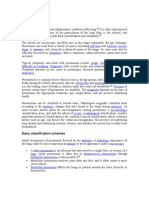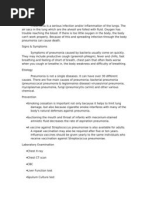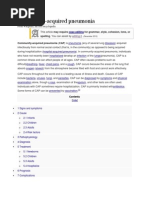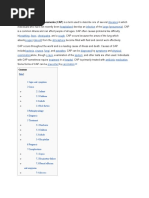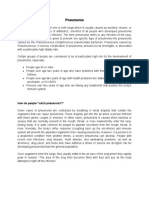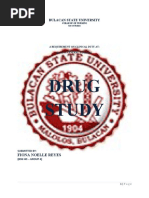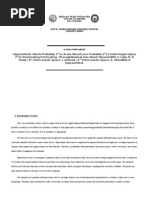Pneumonia
Pneumonia
Uploaded by
John Philip M. Lacas RNCopyright:
Available Formats
Pneumonia
Pneumonia
Uploaded by
John Philip M. Lacas RNCopyright
Available Formats
Share this document
Did you find this document useful?
Is this content inappropriate?
Copyright:
Available Formats
Pneumonia
Pneumonia
Uploaded by
John Philip M. Lacas RNCopyright:
Available Formats
Pneumonia
Pneumonia is an inflammatory illness of the lung. Frequently, it is described
as lung parenchyma/alveolar inflammation and abnormal alveolar filling with
fluid (consolidation and exudation).
The alveoli are microscopic air-filled sacs in the lungs responsible for
absorbing oxygen. Pneumonia can result from a variety of causes, including
infection with bacteria, viruses, fungi, or parasites, and chemical or physical
injury to the lungs. Its cause may also be officially described as idiopathic—
that is, unknown—when infectious causes have been excluded.
Typical symptoms associated with pneumonia include cough, chest pain,
fever, and difficulty in breathing. Diagnostic tools include x-rays and
examination of the sputum. Treatment depends on the cause of pneumonia;
bacterial pneumonia is treated with antibiotics.
Pneumonia is a common illness which occurs in all age groups, and is a
leading cause of death among the elderly and people who are chronically and
terminally ill. Additionally, it is the leading cause of death in children under
five years old worldwide.[3] Vaccines to prevent certain types of pneumonia
are available. The prognosis depends on the type of pneumonia, the
appropriate treatment, any complications, and the person's underlying
health.
General Classification of Pneumonia
Typical Pneumonia
Typical pneumonia is usually acquired by bronchogenic spread of the
pathogen. The organism may also manifest itself as a suprainfection in
patients previously infected by an upper or lower respiratory viral infection.
There is no age-specific predisposition; however the incidence of infection
increases with advancing age.
Types:
• Bacterial Pneumonia
Bacterial pneumonia is caused by various bacteria. The Streptococcus
pneumoniae is the most common bacterium that causes bacterial
pneumonia. It usually occurs when the body is weakened in some way,
such as illness, malnutrition, old age, or impaired immunity, and the
bacteria are able to work their way into the lungs. Bacterial pneumonia
can affect all ages, but those at greater risk include persons who abuse
alcohol, persons who are debilitated, post-operative patients, persons with
respiratory diseases or viral infections, and persons who have weakened
immune systems.
The symptoms of bacterial pneumonia include shaking, chills,
chattering teeth, severe chest pain, high temperature, heavy perspiring,
rapid pulse, rapid breathing, bluish color to lips and nail beds, confused
mental state or delirium, cough that produces rust-colored or greenish
mucus. Viral pneumonia is caused by various viruses, and is the cause of
half of all cases of pneumonia. Early symptoms of viral pneumonia are the
same as those of bacterial pneumonia, which may be followed by
increasing breathlessness and a worsening of the cough. Viral pneumonias
may make a person susceptible to bacterial pneumonia.
• Aspiration Pneumonia
Aspiration pneumonia is an inflammation of the lungs and bronchial
tubes caused by inhaling foreign material, usually food, drink, vomit, or
secretions from the mouth into the lungs. This may progress to form a
collection of pus in the lungs (lung abscess). Aspiration of foreign material
(often the stomach contents) into the lung can be a result of disorders
that affect normal swallowing, disorders of the esophagus (esophageal
stricture, gastroesophageal reflux), or decreased or absent gag reflex (in
unconscious, or semi-conscious individuals). Old age, dental problems, use
of sedative drugs, anesthesia, coma and excessive alcohol consumption
are also causal or contributing factors. The response of the lungs depends
upon the characteristics and amount of the aspirated substance. The
more acidic the material, the greater the degree of lung injury, although
this may not necessary lead to pneumonia.
• Hospital-Acquired Pneumonia
Hospital-acquired pneumonia is an infection of the lungs contracted
during a hospital stay. Pneumonia is a very common illness. It is caused
by many different organisms and can range in seriousness from mild to
life-threatening. Hospital-acquired pneumonia tends to be more serious
because defense mechanisms against infection are often impaired during
a hospital stay, and the kinds of infecting organisms are more dangerous
than those generally encountered in the community. Risk factors
predisposing people to hospital-acquired pneumonia are alcoholism, older
age, immunosuppression from medications or diseases, recent illness, and
risk of aspiration.
• Community-Acquired Pneumonia (CAP)
Community-acquired pneumonia (CAP) is a serious illness. It is the
fourth most common cause of death in the UK, and sixth in the USA. 85%
of cases of CAP are caused by the typical bacterial pathogens, namely,
Streptococcus pneumoniae, Haemophilus influenzae, and Moraxella
catarrhalis. The remaining 15% are caused by atypical pathogens, namely
Mycoplasma pneumoniae, Chlamydia pneumoniae, and Legionella
species. Unusual aerobic gram-negative bacilli (for example,
Pseudomonas aeruginosa, Acinetobacter, Enterobacter) rarely cause CAP.
Atypical Pneumonia
Atypical pneumonia is a pneumonia that does not respond to the usual
antibiotic treatment. It can be caused by bacteria, in particular Mycoplasma
pneumoniae, Chlamydia pneumoniae, Legionella pneumophila and Bordatella
pertussis, or viruses including influenza and coronaviruses. Normally, these
infections are not as severe as typical pneumonia, but legionella causes
legionnaire’s disease, which kills up to 50% of its victims if left untreated.
Types:
• Mycoplasma Pneumonia
Mycoplasma pneumonia has somewhat different symptoms and
physical signs. It is caused by mycoplasmas, the smallest free-living
agents of disease in humankind, which have the characteristics of both
bacteria and viruses, but which are not classified as either. They generally
cause a mild, widespread pneumonia that affects all age groups.
Symptoms include a severe cough that may produce some mucus.
Mycoplasma pneumonia often affects younger people and may be
associated with symptoms outside of the lungs (such as anemia and
rashes), and neurological syndromes (such as meningitis, myelitis, and
encephalitis). Severe forms of Mycoplasma pneumonia have been
described in all age groups. Chlamydophila pneumonia occurs year round
and accounts for 5-15% of all pneumonias. It is usually mild with a low
mortality rate. In contrast, atypical pneumonia due to Legionella accounts
for 2-6% of pneumonias and has a higher mortality rate. Elderly
individuals, smokers, and people with chronic illnesses and weakened
immune systems are at higher risk for this type of pneumonia. Contact
with contaminated aerosol systems (like infected air conditioning systems)
has also been associated with pneumonia due to Legionella.
• Legionnaire's Disease
Legionnaire's disease is an acute respiratory infection caused by the
bacterium Legionella pneumophila, which can cause a broad spectrum of
disease from mild cough and fever to a serious pneumonia. The bacteria
that cause Legionnaire's disease have been found in water delivery
systems and can survive in the warm, moist, air conditioning systems of
large buildings including hospitals. The infection is transmitted through
the respiratory system. Person-to-person spread has not been proved.
From the onset of symptoms, the condition typically worsens during the
first 4 to 6 days, with improvement starting in another 4 to 5 days. Most
infection occurs in middle-aged or older people, although it has been
reported in children. Typically, the disease is less severe in children.
• Pneumocystis (Carinii) Jirovecii Pneumonia
Pneumocystis carinii pneumonia is an infection of the lungs caused by
the fungus Pneumocystis carinii. PCP is a pneumonia caused by the fungal
organism Pneumocystis carinii, which is widespread in the environment,
and is not a pathogen (does not cause illness) in healthy individuals.
However, in individuals with weakened immune systems due to cancer,
HIV/AIDS, solid organ and/or bone marrow transplantation, as well as
individuals receiving chronic corticosteroids or other medications that
affect the immune system, Pneumocystis carinii may lead to a lung
infection. Individuals with advanced AIDS are of particular interest, since
PCP was a relatively rare infection prior to the AIDS epidemic. Before the
use of preventive antibiotics for PCP, up to 70% of individuals in the U.S.
with advanced AIDS would develop PCP.
Pneumonia in an immunocompromised host describes a lung infection
that occurs in a person whose infection-fighting mechanisms are
significantly impaired. People who are immunocompromised have a
defective immune response. Because of this, they are susceptible to
infections by microorganisms that are present everywhere, but do not
normally cause disease in healthy people. They are also more susceptible
to the usual causes of pneumonia, which can affect anyone.
Immunosuppression can be caused by HIV infection, leukemia, organ
transplantation, bone marrow transplant, and medications to treat cancer.
Viral pneumonia is an inflammation (irritation and swelling) of the
lungs caused by infection with a virus. Pneumonia is an infection of the
lung that affects 1 out of 100 people annually. Viral pneumonia is caused
by one of several viruses, including influenza, parainfluenza, adenovirus,
rhinovirus, herpes simplex virus, respiratory syncytial virus, hantavirus,
and cytomegalovirus. Most cases of viral pneumonia are mild and get
better without treatment, but some cases are more serious and require
hospitalization. People at risk for more serious viral pneumonia typically
have impaired immune systems such as people with HIV, transplant
patients, young children (especially those with heart defects), the elderly,
and people taking medications to suppress their immune systems in the
treatment of autoimmune disorders.
• Severe Acute Respiratory Syndrome
Severe Acute Respiratory Syndrome (SARS) is a respiratory disease in
humans which is caused by the SARS coronavirus. There has been one
near pandemic to date, between the months of November 2002 and July
2003, with 8,096 known infected cases and 774 deaths (a case-fatality
rate of 9.6%) worldwide being listed in the World Health Organization's
(WHO) 21 April 2004 concluding report. Within a matter of weeks in early
2003, SARS spread from the Guangdong province of China to rapidly
infect individuals in some 37 countries around the world.
Mortality by age group as of 8 May 2003 is below 1% for people aged
24 or younger, 6% for those 25 to 44, 15% in those 45 to 64 and more
than 50% for those over 65. For comparison, the case fatality rate for
influenza is usually around 0.6% (primarily among the elderly) but can rise
as high as 33% in locally severe epidemics of new strains. The mortality
rate of the primary viral pneumonia form is about 70%.
As of May 2006, the spread of SARS has been fully contained thanks to
the efforts of the WHO, with the last infected human case seen in June
2003 (disregarding a laboratory induced infection case in 2004). However,
SARS is not claimed to have been eradicated (unlike smallpox), as it may
still be present in its natural host reservoirs (animal populations) and may
potentially return into the human population in the future.
Risk Factors
The elderly (who tend to have diminished cough and gag reflexes and
faltering immune systems) and infants and young children (who have
immature immune systems and small airways) are at greater risk of
community-acquired pneumonia (CAP) than are young and middle-aged
adults.
Certain individuals, such as the elderly, the very young, and those with
chronic or severe medical conditions, are of course at higher risk of
community-acquired pneumonia (CAP). Hospitalized patients are particularly
vulnerable to gram-negative bacteria and staphylococci, which can be very
dangerous, particularly in people who are already ill.
People, especially the elderly, who have recently had surgery or
suffered a traumatic injury, are also more likely to develop pneumonia
because they are less able to breathe deeply, cough, and get rid of mucous.
Pneumonia is more likely to occur in people whose immune system is
weakened by an existing illness, such as the flu, cancer, or AIDS, and in
people with chronic conditions, such as sickle cell disease, heart disease,
diabetes, kidney disease, asthma, chronic bronchitis, chronic obstructive
pulmonary disease (COPD), emphysema, or cystic fibrosis.
Recruits on military bases and college students are at higher than
average risk for Mycoplasma Pneumonia, which is usually mild. These groups
are at lower risk, however, for more serious types of pneumonia.
Frequent exposure to cigarette smoke can affect the lungs in ways that
make a person more likely to develop pneumonia. The risk for pneumonia in
smokers of more than a pack a day is three times that of nonsmokers. Those
who are chronically exposed to cigarette smoke, which can injure airways
and damage the cilia, are also at risk. Toxic fumes, industrial smoke, and
other air pollutants may also damage cilia function, which is a defense again
bacteria in the lungs.
Alcohol or drug abuse is strongly associated with pneumonia. These
substances act as sedatives and can diminish the reflexes that trigger
coughing and sneezing. Alcohol also interferes with the actions of
macrophages, the white blood cells that destroy bacteria and other microbes.
Intravenous drug abusers are at risk for pneumonia from infections that
originate at the injection site and spread through the blood stream to the
lungs.
Signs and Symptoms
The most common symptoms of pneumonia are shortness of breath;
chest pain, especially when breathing in; coughing; shallow, rapid breathing;
and fever and chills. Coughs usually bring up mucus, also called sputum. The
sputum may even be streaked with blood or pus.
In serious cases, the patient's lips or nail bed will appear blue due to
lack of oxygen. Physical examination may detect tachypnea and signs of
consolidation, such as crackles with bronchial breath sounds. This syndrome
is commonly caused by bacteria, such as S. pneumoniae and H. influenzae.
People who have bacterial pneumonia usually are very sick. Symptoms
of bacterial pneumonia usually begin suddenly and often develop during or
after an upper respiratory infection, such as influenza or a cold. Symptoms of
viral pneumonia are often less obvious, less severe, and come on gradually.
Viral pneumonia often goes unrecognized because the person may not
appear very ill. The symptoms vary with age and whether the person has
other health problems. Pneumonia caused by anaerobic bacteria such as
Bacteroides can produce dangerous abscesses in the lungs. People with such
pneumonias may have prolonged fever and productive cough, frequently
showing blood in the sputum. Signs of blood may indicate dead lung tissue
(necrosis). About a third of these patients experience weight loss.
Older adults may have milder symptoms, such as a dry
(nonproductive) cough. Sometimes there may be no fever. A change in
mental status (confusion or delirium) or worsening of an underlying lung
disease may be the major sign of pneumonia in older adults.
Diagnosis
The diagnosis of pneumonia is usually made from a medical history, a
physical examination, a chest X-ray and chest thoracentesis.
Treatment
Treatment of pneumonia consists of respiratory support, including O2 if
indicated, and antibiotics, which are selected on the basis of Gram stain
results. If Gram stain is not performed or does not establish a diagnosis,
antibiotics are selected on the basis of probabilities according to patient age,
epidemiology, host risk factors, and severity of illness.
Antibiotics are the main causal therapy for pneumonia. The antibiotics
that are used depend on the nature of the pneumonia and the immune status
of the patient. Amoxicillin is used as first-line therapy in the vast majority of
community patients, sometimes with added clarithromycin. In North America,
where the atypical forms of community acquired pneumonia are becoming
more common, clarithromycin, azithromycin, and the fluoroquinolones have
displaced the penicillin-derived drugs as first line therapy. In hospitalized
patients and immune deficient patients, local guidelines generally determine
which combination of (generally intravenous) antibiotics is used. When in the
hospital, respiratory treatments to remove secretions may be necessary.
Occasionally, steroid medications may be used to reduce wheezing if there is
an underlying lung disease.
Prevention
A very common method for transmitting a cold is by shaking hands.
Everyone should always wash his or her hands before eating and after going
outside. Ordinary soap is sufficient. Waterless hand cleaners that contain an
alcohol-based gel are also effective for every day use and may even kill cold
viruses. Daily diets should include foods such as fresh, dark-colored fruits and
vegetables, which are rich in antioxidants and other important food chemicals
that help boost the immune system.
Deep-breathing exercises and therapy to clear secretions help prevent
pneumonia in people at high risk, such as those who have had chest or
abdominal surgery and those who are debilitated. People with pneumonia
also need to clear secretions and benefit from deep-breathing exercises and
therapy as well. If people with pneumonia are short of breath or their blood is
low in oxygen, supplemental oxygen is provided. Although rest is an
important part of treatment, moving often and getting out of bed and into a
chair are encouraged.
Several types of pneumonia can be prevented with the use of vaccines.
Vaccines are available to protect against pneumococcal pneumonia,
pneumonia caused by the bacterium Haemophilus influenzae, and pneumonia
caused by the influenza virus, which also often leads to a secondary bacterial
pneumonia. People over age 65 and those in high-risk groups are advised to
receive the pneumonia vaccine. The vaccine is effective in approximately 80
percent of healthy young adults; however, it may be less effective in people
in high risk groups. Healthy older adults usually need only one shot for
lifetime protection. People with a chronic medical problem are encouraged to
have the vaccine every 5 to 6 years. Some health professionals recommend
that everyone over the age of 65 receive the vaccine every 5 years.
Nursing Intervention
Nursing interventions and responsibilities in caring for the patient with
pneumonia include administering oxygen and medications as prescribed and
monitoring for their effects. Monitoring vital signs including oxygen level,
monitoring lung sounds, watching for edema and patients feeling of
shortness of breath. It may also include doing chest physiotherapy, educating
on the use of incentive spirometry and flutter valve. If the patient is immobile
it is imperative that the patient be turned every two hours and encouraged to
cough and deep breathe. If the patient has a tracheotomy proper tract care
and suctioning after hyperoxygenating is also a responsibility.
Complication
Complications of pneumonia that may occur include buildup of fluid in
the space between the lung and chest wall (pleural effusion), pockets of pus
that form in the space between the lung and chest wall (empyema) or in the
lung itself (lung abscess), secondary bacterial lung infection after a viral
infection, secondary infection, such as a vaginal infection or infections of the
digestive system, because of antibiotic therapy, bacteria in the bloodstream
(bacteremia) or throughout the body (septicemia), infection caused by
swelling of the covering of the spinal cord (meningitis), infection of a joint
caused by spread of bacteria through the bloodstream (septic arthritis), and
infection of the heart muscle or the sac surrounding the heart (endocarditis
or pericarditis).
BASIC PATHOPHYSIOLOGY OF BACTERIAL PNEUMONIA
MODIFIABLE NON-
MODIFIABLE
IFESTYLE & ENVIRONMENT AGE
ENTRY OF PNEUMOCOCCI
INFLAMMATORY RXN
PRODUCTION OF EXUDATE MIGRATION OF WBC
TO AVEOLI
EXUDATE INTERFERE WITH MORE SOLID STRACTURE OF
THE
MOVEMENT OR DIFFUSION AIR CONTAINING
SPACES
O2 & CO2 BECAME FILLED
DECREASED VENTILATION
BLOOD SHUNTING
HYPOXEMIA
BULACAN STATE UNIVERSITY
COLLEGE OF NURSING
CITY OF MALOLOS BULACAN
OUTPUT IN CLINICAL DUTY
(EMILIO G. PEREZ DISTRICT HOSPITAL)
SUBMITTED BY:
JOHN PHILIP M. LACAS
BSN 3D GROUP 3
SUBMITTED TO:
MARIBEL VALENCIA, R.N
CLINICAL INSTRUCTOR
You might also like
- Jci 8th Update (Outside)Document122 pagesJci 8th Update (Outside)jooorysf100% (2)
- DR Jessica Taylor - Sexy But Psycho - How The Patriarchy Uses Women's Trauma Against Them (2022, Hachette UK) - Libgen - LiDocument370 pagesDR Jessica Taylor - Sexy But Psycho - How The Patriarchy Uses Women's Trauma Against Them (2022, Hachette UK) - Libgen - LiEszter100% (6)
- Pubh 302 MemoDocument3 pagesPubh 302 Memoapi-530235855No ratings yet
- Initial Data BaseDocument16 pagesInitial Data BaseJohn Philip M. Lacas RN0% (1)
- COVID-19 Dummy ReportDocument2 pagesCOVID-19 Dummy ReportVirat DaineNo ratings yet
- Premature LabourDocument29 pagesPremature LabourSanthosh.S.U100% (4)
- Pneumonia WrittenDocument12 pagesPneumonia WrittenFereli Joy SupanNo ratings yet
- 3 PneumoniaDocument17 pages3 PneumoniaMohamed Na3eemNo ratings yet
- She ReenDocument23 pagesShe Reenmonamoustafadm99No ratings yet
- Case Study For PneumoniaDocument11 pagesCase Study For PneumoniaGabbii Cinco100% (1)
- Pneumonia Is An: ClinicalDocument13 pagesPneumonia Is An: ClinicaldfgsfsfssdNo ratings yet
- Fast Facts On PneumoniaDocument6 pagesFast Facts On PneumoniaAndeariesa DarmansiusNo ratings yet
- Pneumonia 3Document8 pagesPneumonia 3janinecasilenNo ratings yet
- What Is Pneumonia?Document12 pagesWhat Is Pneumonia?rose angela0% (1)
- PneumoniaDocument8 pagesPneumoniaNader Smadi100% (2)
- Nursing Care Management 103 Cap MRDocument9 pagesNursing Care Management 103 Cap MRkarenfaye00No ratings yet
- Biology investigatory project (1)Document25 pagesBiology investigatory project (1)Joe HamacherNo ratings yet
- What Is PneumoniaDocument15 pagesWhat Is PneumoniaKram Simon Sapongay100% (2)
- CommunityDocument17 pagesCommunityRosemarie GonzalesNo ratings yet
- PneumoniaDocument1 pagePneumoniaJozepf AgustinNo ratings yet
- Signs and Symptoms: Community-Acquired Pneumonia (CAP) Is One of SeveralDocument12 pagesSigns and Symptoms: Community-Acquired Pneumonia (CAP) Is One of SeveralJohanna Fe Tadena ClerigoNo ratings yet
- Epidemiology of TBDocument4 pagesEpidemiology of TByam pdNo ratings yet
- Central Academy: Biology ProjectDocument12 pagesCentral Academy: Biology ProjectMastbleNo ratings yet
- Bruyere Case13 001-012 DSDocument11 pagesBruyere Case13 001-012 DSjrnataNo ratings yet
- Pneumonia Is An Inflammatory Condition of The LungDocument24 pagesPneumonia Is An Inflammatory Condition of The LungJhoana B. BritanicoNo ratings yet
- Name: Chintiya Cahaya Putri NIM: P20637020008 Class: 1A Prodi: Diii RmikDocument37 pagesName: Chintiya Cahaya Putri NIM: P20637020008 Class: 1A Prodi: Diii RmikChintiya PutriNo ratings yet
- Pneumonia Is An Inflammatory Condition of The Lung, Especially ofDocument14 pagesPneumonia Is An Inflammatory Condition of The Lung, Especially ofNar Patrick PadillaNo ratings yet
- Clinical Presentation On PnemoniaDocument37 pagesClinical Presentation On PnemoniasreekalaNo ratings yet
- PneumoniaDocument18 pagesPneumoniaFryam Bells100% (1)
- Pneumonia 1Document17 pagesPneumonia 1Jonathan katanaNo ratings yet
- 584 1130 1 PBDocument3 pages584 1130 1 PBAlden Lui SevillaNo ratings yet
- Pneumonia: DR Abdul Ghani WaseemDocument20 pagesPneumonia: DR Abdul Ghani WaseemFarwaNo ratings yet
- Pneumonia IntroductionDocument3 pagesPneumonia Introductiondareine22No ratings yet
- PneumoniaDocument2 pagesPneumoniaNicoleNo ratings yet
- Hindi Pa Tapos 101Document24 pagesHindi Pa Tapos 101Angel CauilanNo ratings yet
- PDA PneumoniaDocument8 pagesPDA Pneumoniagray_angelNo ratings yet
- Pneumonia Is AnDocument9 pagesPneumonia Is Ansandro2000No ratings yet
- Community Acquired PneumoniaDocument7 pagesCommunity Acquired PneumoniaJoshuaOng100% (1)
- Community-Acquired Pneumonia (CAP) Is A Term Used To Describe One of SeveralDocument13 pagesCommunity-Acquired Pneumonia (CAP) Is A Term Used To Describe One of SeveralDan Oliver RietaNo ratings yet
- Pneumonia PPT NewDocument22 pagesPneumonia PPT NewOsuri MapitigamaNo ratings yet
- Community Acquires PneumoniaDocument3 pagesCommunity Acquires PneumoniabaniniycsebNo ratings yet
- Pneumonia CHN Case ReportDocument6 pagesPneumonia CHN Case ReportRhaine MagtotoNo ratings yet
- Pneumonia: Pneumococcus. A Serious Complication of Pneumonia, Pneumococcal Meningitis, Is AssociatedDocument7 pagesPneumonia: Pneumococcus. A Serious Complication of Pneumonia, Pneumococcal Meningitis, Is AssociatedHannah YtacNo ratings yet
- Case Study of Pneumonia With Underlying Covid 19Document41 pagesCase Study of Pneumonia With Underlying Covid 19Angel CauilanNo ratings yet
- PNEUMONIA NotesDocument4 pagesPNEUMONIA NotesKate HizonNo ratings yet
- Case Study PneumoniaDocument53 pagesCase Study PneumoniaWilliam Agoncillo100% (1)
- Pneumonia Disease Risk FactorsDocument3 pagesPneumonia Disease Risk FactorsPedialy AvilesNo ratings yet
- 1 Running Head: Disease Report On Causes and Prevention of PneumoniaDocument4 pages1 Running Head: Disease Report On Causes and Prevention of PneumoniawaweruhNo ratings yet
- Group 2 Community Acquired PneumoniaDocument24 pagesGroup 2 Community Acquired PneumoniaalyanadayritNo ratings yet
- Pneumonia Is A Serious Infection of The Lungs in Which The AirDocument1 pagePneumonia Is A Serious Infection of The Lungs in Which The AirErdem EzerNo ratings yet
- Addis Ababa University: Collage of Health Science Pediatrics and Neonatology On PneumoniaDocument21 pagesAddis Ababa University: Collage of Health Science Pediatrics and Neonatology On PneumoniaCheru Dugase100% (1)
- PneumoniaDocument10 pagesPneumoniasridevi kothamasuNo ratings yet
- Bruyere Case13 001-012 DSDocument11 pagesBruyere Case13 001-012 DSSheila May LumhodNo ratings yet
- PneumoniaDocument55 pagesPneumoniaGlenn ValerioNo ratings yet
- What Is PneumoniaDocument16 pagesWhat Is PneumoniasakuraleeshaoranNo ratings yet
- PneumoniaDocument2 pagesPneumoniaMargaret EricksonNo ratings yet
- Case StudyDocument13 pagesCase StudyGeevee Naganag VentulaNo ratings yet
- Lec.2 Respirotary System SaifDocument19 pagesLec.2 Respirotary System Saifs2111110520No ratings yet
- Bai FinalDocument2 pagesBai Finalpcj9qvmjgdNo ratings yet
- Pneumonia: Pneumonia Is An Inflammatory Condition of The Lung. It Is Often Characterized AsDocument13 pagesPneumonia: Pneumonia Is An Inflammatory Condition of The Lung. It Is Often Characterized AsBettina Gem M. PeñalosaNo ratings yet
- I SearchresearchpneumoniaDocument7 pagesI Searchresearchpneumoniaapi-277487340No ratings yet
- Respiratory DiseasesDocument11 pagesRespiratory DiseasesMichael Angelo SeñaNo ratings yet
- Learn About PneumoniaDocument2 pagesLearn About PneumoniaKimberly Descuatan100% (1)
- QUARTER 3 - Communicablediseasesfinal-EditedDocument66 pagesQUARTER 3 - Communicablediseasesfinal-EditedJocel May TaboradaNo ratings yet
- Drug Study Batch 2Document17 pagesDrug Study Batch 2John Philip M. Lacas RNNo ratings yet
- Drug Study Batch 1Document17 pagesDrug Study Batch 1John Philip M. Lacas RNNo ratings yet
- Obstructive Jaundice, Choledocholithiasis Calculus CholecystitisDocument36 pagesObstructive Jaundice, Choledocholithiasis Calculus CholecystitisJohn Philip M. Lacas RN67% (3)
- Acute Calculous CholecystitisDocument26 pagesAcute Calculous CholecystitisJohn Philip M. Lacas RN100% (1)
- Sexually Transmitted Disease: Submitted By: John Philip M. Lacas (BSN Iii-D Group 3)Document30 pagesSexually Transmitted Disease: Submitted By: John Philip M. Lacas (BSN Iii-D Group 3)John Philip M. Lacas RNNo ratings yet
- Bulacan State University: College of NursingDocument29 pagesBulacan State University: College of NursingJohn Philip M. Lacas RN100% (3)
- Instructional PlansDocument10 pagesInstructional PlansJohn Philip M. Lacas RNNo ratings yet
- The Constitutional Right To Health Among FilipinosDocument11 pagesThe Constitutional Right To Health Among FilipinosMA.SAMANTHA RAMOSNo ratings yet
- Ultrasound Guided Vascular AccessDocument19 pagesUltrasound Guided Vascular Accessdragon_hubo100% (2)
- Posterior Pituitary Disorder RomeoDocument19 pagesPosterior Pituitary Disorder RomeoSavin PetersNo ratings yet
- Gbagada General HospitalDocument1 pageGbagada General HospitalChijioke PaschalNo ratings yet
- Health Care Provider Form -Own Health ConditionDocument2 pagesHealth Care Provider Form -Own Health Conditionkppmftq87nNo ratings yet
- Use of Treatment RoomDocument55 pagesUse of Treatment RoomDarren CariñoNo ratings yet
- In Cardiothoracic Surgery: Program Specification For M.D DegreeDocument9 pagesIn Cardiothoracic Surgery: Program Specification For M.D DegreeAbdisamad SaidNo ratings yet
- Daftar Pustaka 2Document3 pagesDaftar Pustaka 2indigoNo ratings yet
- Postpartum Issues - Postpartum Depression, Weight Management, Sexual Dysfunction, Difficult Breastfeeding ProblemsDocument63 pagesPostpartum Issues - Postpartum Depression, Weight Management, Sexual Dysfunction, Difficult Breastfeeding ProblemsWinnie Lorraine Umali-PascualNo ratings yet
- CT BR PROTECT A Partnership To Achieve ALARA On Aquilion CTDocument3 pagesCT BR PROTECT A Partnership To Achieve ALARA On Aquilion CTakeem alturkiNo ratings yet
- Lect 7. EarDocument26 pagesLect 7. Earhla592071No ratings yet
- Discharge Planning PaperDocument5 pagesDischarge Planning Paperapi-283173905No ratings yet
- Laai Guidelines - v5 - 0118 0 PDFDocument27 pagesLaai Guidelines - v5 - 0118 0 PDFadam lawrence100% (1)
- 2nd Prof Catalogue 2019 LRDocument40 pages2nd Prof Catalogue 2019 LRGangadhar DungaNo ratings yet
- Asthalin InhalerDocument7 pagesAsthalin InhalerINDAH WIDYANING TYASNo ratings yet
- 2018-BJOG An International Journal of Obstetrics & GynaecologyDocument40 pages2018-BJOG An International Journal of Obstetrics & GynaecologyBagusHibridaNo ratings yet
- Planning and Design Hospitals Other Facilities 2Document6 pagesPlanning and Design Hospitals Other Facilities 2Martin Rilloraza Jr.No ratings yet
- Causes, Incidence, and Risk Factors: HIV DiseaseDocument8 pagesCauses, Incidence, and Risk Factors: HIV DiseaseAminath SamaNo ratings yet
- Indicators of Maternal MortalityDocument14 pagesIndicators of Maternal Mortalityutsavshrestha05No ratings yet
- Weekly Home Learning Plan: Physical Education & Health SY: 2021-2022 Grade 11C - St. SebastianDocument3 pagesWeekly Home Learning Plan: Physical Education & Health SY: 2021-2022 Grade 11C - St. SebastianJohn Carlo Cabiles MellizaNo ratings yet
- Brach y TherapyDocument2 pagesBrach y Therapyrakoon4No ratings yet
- Pengaruh Posisi Condong Kedepan Dan Terapi Pursed Lips Breathing Terhadap Derajat Sesak Napas Penderita Penyakit Paru Obstruktif Kronik (PPOK)Document7 pagesPengaruh Posisi Condong Kedepan Dan Terapi Pursed Lips Breathing Terhadap Derajat Sesak Napas Penderita Penyakit Paru Obstruktif Kronik (PPOK)Leli FebriantiNo ratings yet
- MD Peadiatrics NMC CURRICULUMDocument67 pagesMD Peadiatrics NMC CURRICULUMraghava mbbs100% (1)
- Funda Lab ReviewerDocument3 pagesFunda Lab Reviewernerys3367No ratings yet
- Classic Versus Type II Enteropathy-Associated T-Cell LymphomaDocument5 pagesClassic Versus Type II Enteropathy-Associated T-Cell Lymphomaderek lauNo ratings yet




























